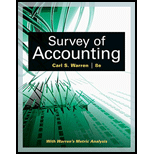
Survey of Accounting (Accounting I)
8th Edition
ISBN: 9781305961883
Author: Carl Warren
Publisher: Cengage Learning
expand_more
expand_more
format_list_bulleted
Question
Chapter 5, Problem 5.4.2MBA
To determine
Concept Introduction:
Cash Flow statement:
The Cash flow statement shows the movement of cash during a particular period. The
- Cash flows from operating activities
- Cash Flows from investing activities
- Cash flows from financing activities
(Note: Cash flows from operating activities can be prepared using direct or indirect method)
To Indicate:
The Comparison of results
Expert Solution & Answer
Want to see the full answer?
Check out a sample textbook solution
Students have asked these similar questions
Please provide the accurate answer to this general accounting problem using appropriate methods.
I need guidance with this general accounting problem using the right accounting principles.
Ques 8
Chapter 5 Solutions
Survey of Accounting (Accounting I)
Ch. 5 - Prob. 1SEQCh. 5 - Prob. 2SEQCh. 5 - Prob. 3SEQCh. 5 - Adjustments to the company’s records based on the...Ch. 5 - Prob. 5SEQCh. 5 - Prob. 1CDQCh. 5 - Prob. 2CDQCh. 5 - Prob. 3CDQCh. 5 - Prob. 4CDQCh. 5 - Prob. 5CDQ
Ch. 5 - Prob. 6CDQCh. 5 - Prob. 7CDQCh. 5 - Prob. 8CDQCh. 5 - Prob. 9CDQCh. 5 - Assume that Leslie Hunter, accounts payable clerk...Ch. 5 - Prob. 11CDQCh. 5 - The accounting clerk pays all obligations by...Ch. 5 - Prob. 13CDQCh. 5 - Prob. 14CDQCh. 5 - Do items reported as a credit memorandum on the...Ch. 5 - Prob. 16CDQCh. 5 - Prob. 17CDQCh. 5 - Prob. 5.1ECh. 5 - Prob. 5.2ECh. 5 - Prob. 5.3ECh. 5 - Prob. 5.4ECh. 5 - Prob. 5.5ECh. 5 - Prob. 5.6ECh. 5 - Prob. 5.7ECh. 5 - Prob. 5.8ECh. 5 - Prob. 5.9ECh. 5 - Prob. 5.10ECh. 5 - Prob. 5.11ECh. 5 - Prob. 5.12ECh. 5 - Prob. 5.13ECh. 5 - Prob. 5.14ECh. 5 - Prob. 5.15ECh. 5 - Prob. 5.16ECh. 5 - Prob. 5.17ECh. 5 - Prob. 5.18ECh. 5 - Prob. 5.19ECh. 5 - Entries for note collected by bank Accompanying a...Ch. 5 - Prob. 5.21ECh. 5 - Prob. 5.22ECh. 5 - Prob. 5.23ECh. 5 - Prob. 5.24ECh. 5 - Prob. 5.25ECh. 5 - Prob. 5.1PCh. 5 - Prob. 5.2.1PCh. 5 - Prob. 5.2.2PCh. 5 - Prob. 5.3.1PCh. 5 - Prob. 5.3.2PCh. 5 - Prob. 5.4.1PCh. 5 - Prob. 5.4.2PCh. 5 - Prob. 5.4.3PCh. 5 - Prob. 5.4.4PCh. 5 - Prob. 5.1.1MBACh. 5 - Prob. 5.1.2MBACh. 5 - Prob. 5.1.3MBACh. 5 - Prob. 5.1.4MBACh. 5 - Ratio of cash to monthly cash expenses AcelRx...Ch. 5 - Prob. 5.2.1MBACh. 5 - Prob. 5.2.2MBACh. 5 - Ratio of cash to monthly cash expenses Pacira...Ch. 5 - Ratio of cash to monthly cash expenses Pacira...Ch. 5 - Prob. 5.2.5MBACh. 5 - Prob. 5.3.1MBACh. 5 - Prob. 5.3.2MBACh. 5 - Prob. 5.3.3MBACh. 5 - Prob. 5.3.4MBACh. 5 - Prob. 5.3.5MBACh. 5 - Prob. 5.4.1MBACh. 5 - Prob. 5.4.2MBACh. 5 - Prob. 5.1CCh. 5 - Prob. 5.2CCh. 5 - Prob. 5.3CCh. 5 - Prob. 5.4CCh. 5 - Prob. 5.5.1CCh. 5 - Prob. 5.5.2CCh. 5 - Prob. 5.5.3CCh. 5 - Prob. 5.6C
Knowledge Booster
Similar questions
arrow_back_ios
SEE MORE QUESTIONS
arrow_forward_ios
Recommended textbooks for you
 Survey of Accounting (Accounting I)AccountingISBN:9781305961883Author:Carl WarrenPublisher:Cengage Learning
Survey of Accounting (Accounting I)AccountingISBN:9781305961883Author:Carl WarrenPublisher:Cengage Learning Essentials of Business Analytics (MindTap Course ...StatisticsISBN:9781305627734Author:Jeffrey D. Camm, James J. Cochran, Michael J. Fry, Jeffrey W. Ohlmann, David R. AndersonPublisher:Cengage Learning
Essentials of Business Analytics (MindTap Course ...StatisticsISBN:9781305627734Author:Jeffrey D. Camm, James J. Cochran, Michael J. Fry, Jeffrey W. Ohlmann, David R. AndersonPublisher:Cengage Learning Managerial AccountingAccountingISBN:9781337912020Author:Carl Warren, Ph.d. Cma William B. TaylerPublisher:South-Western College Pub
Managerial AccountingAccountingISBN:9781337912020Author:Carl Warren, Ph.d. Cma William B. TaylerPublisher:South-Western College Pub Financial And Managerial AccountingAccountingISBN:9781337902663Author:WARREN, Carl S.Publisher:Cengage Learning,Principles of Accounting Volume 1AccountingISBN:9781947172685Author:OpenStaxPublisher:OpenStax College
Financial And Managerial AccountingAccountingISBN:9781337902663Author:WARREN, Carl S.Publisher:Cengage Learning,Principles of Accounting Volume 1AccountingISBN:9781947172685Author:OpenStaxPublisher:OpenStax College College Accounting, Chapters 1-27AccountingISBN:9781337794756Author:HEINTZ, James A.Publisher:Cengage Learning,
College Accounting, Chapters 1-27AccountingISBN:9781337794756Author:HEINTZ, James A.Publisher:Cengage Learning,

Survey of Accounting (Accounting I)
Accounting
ISBN:9781305961883
Author:Carl Warren
Publisher:Cengage Learning

Essentials of Business Analytics (MindTap Course ...
Statistics
ISBN:9781305627734
Author:Jeffrey D. Camm, James J. Cochran, Michael J. Fry, Jeffrey W. Ohlmann, David R. Anderson
Publisher:Cengage Learning

Managerial Accounting
Accounting
ISBN:9781337912020
Author:Carl Warren, Ph.d. Cma William B. Tayler
Publisher:South-Western College Pub

Financial And Managerial Accounting
Accounting
ISBN:9781337902663
Author:WARREN, Carl S.
Publisher:Cengage Learning,

Principles of Accounting Volume 1
Accounting
ISBN:9781947172685
Author:OpenStax
Publisher:OpenStax College

College Accounting, Chapters 1-27
Accounting
ISBN:9781337794756
Author:HEINTZ, James A.
Publisher:Cengage Learning,